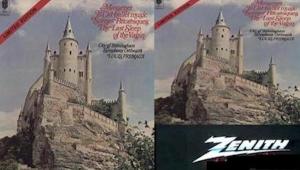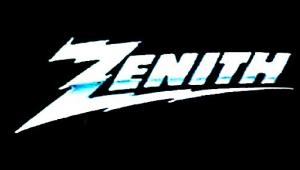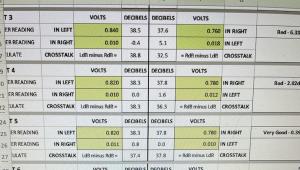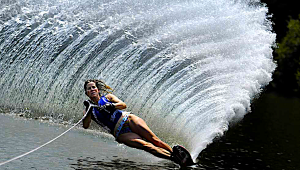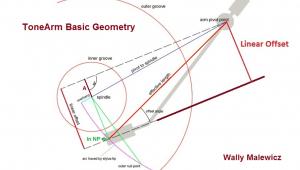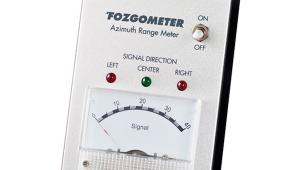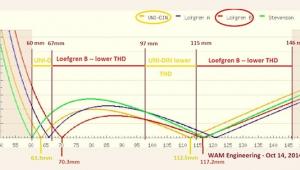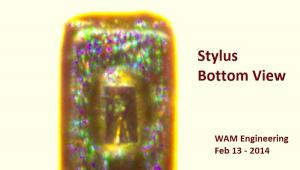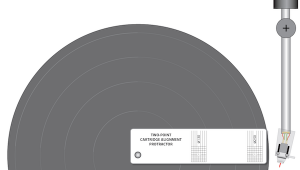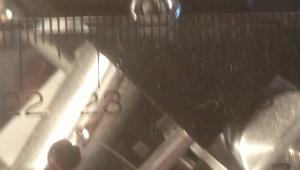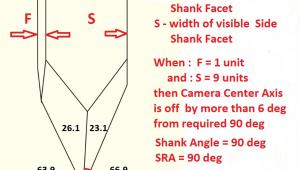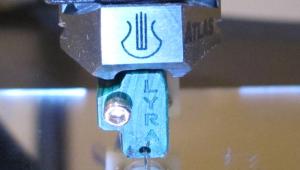Really interesting demo Michael.
What is the software you are using to measure the angles?
Video Showing Setting Stylus Rake Angle Using a Digital USB Microscope
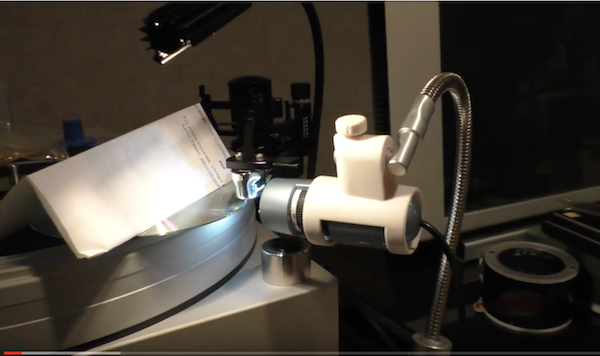
Short explanation: when records are cut the thread of just cut lacquer is extremely volatile and must be vacuumed into a collection jar. The thread must be removed from behind the cutter head, so the cutting stylus must make an angle of more than 90 degrees to the record surface in order to for the thread to be extracted. As you'll read in the analogPlanet story and in the PDF file, the authors traveled throughout America visiting mastering houses and measuring the cutter head stylus rake angles, which varied between 91 and about 94 or so degrees.
They chose 92 as an ideal compromise. However, if you wish to tweak it for every record in your collection, knock yourself out! I find 92 degrees suffices for most records. As for why this matters, you'll also find the answers in the analogPlanet post and the measurements in the PDF, which also includes a very interesting and useful discussion of various stylus profiles and their effect on sound.
- Log in or register to post comments


Michael, how much of a difference does record thickness (150gr to 200gr) have on the rake angel? After setting your rake angle at 92 with a compact disk as your base, do you adjust up or down depending on the album you are playing?

In another Analog Planet post, MF points out that with a 9-inch tonearm, a height adjustment of 4mm at the tonearm is ~1° change in stylus rake angle. (He doesn't mention it in that same post, but longer arms would need more of a change in height to get to a 1° change in SRA. My years of geometry and trigonometry are far behind me, but there is a formula to calculate this.
My point is, the difference of change in SRA with vinyl thickness is only a fraction of a degree. If someone cannot adjust with each play, I'd either set it up for 180g records, or maybe find a middle ground between standard records and 200g records and just run with that. (Ruling out RCA's "dynaflex" records, of course...those almost border on the the thickness of the "sound sheets" that used to be tucked into old National Geographic issues. ;o) )
Thing is, I'm not going to use my digital calipers on my records to see how thick they actually are. ;)

Should have read first... my bad.

Another great "set up tip" was the VTA post that had the chart from Wally to measure channel separation. Can't seem to find it on the site anywhere these days....

If anyone has any leads on a less proprietary software program for a Mac, I'd be forever grateful. My "Pluggable" brand one has software but no angle measurement feature. Thanks

I've also been using the "direct SRA observation" approach but found another method applicable to cartridges NOT YET installed on a tonearm: 1) use the microscope to first observe the angle between the cantilever and the line of contact on the stylus tip, say 110 degrees, 2) install the cartridge and apply normal tracking force, then place the stylus on the (non spinning) record surface, 3) use a smart phone to take a close-up picture and measure the angle between the cantilever and the record surface, say 22 degrees, 4) using simple math, one can derive 180 - (110 - 22) = 92 degrees of SRA.
Taking a picture of the cantilever on the record surface and measuring the angle between the two is relatively easy, compared to observing the SRA directly.

using to measure angle with? Specifically iPhone pics. Same software that MF cites or other? TIA.

I use an an app called Protractor on iPad. It's free but be careful in downloading the correct one since there are several apps with the same name.

Another great "set up tip" was the VTA post that had the chart from Wally to measure channel separation.

I cannot see the importance of VTA adjustments if the more important parameters are perfectly set. Assuming a point contact between needle and grooves neglecting the unwanted deformation of the groove by the tracking forces there should be no VTA effect. The question remains how to control the correct 45 degree angle between the needle axis and the axis of the coils of an MC cartridge? Adjust+ just allows minimising existing problems. Or how to control the correct LTA. You have to trust the manufacturer. And finally: how to control the horizontal axis of the Tonearm being parallel to the surface of the record? I guess VTA discussions are that popular because the adjustments are that easily done. :-) And because there always will be tolerances in manufacturing the adjustment trials of the user have the character of a lottery.

In my case, VTA is important because I have a VPI table and swap between tonearm wands fitted with stereo or mono carts practically daily. Those unipivot arms with dropped-counterweights make time spent tweaking for separation worth it.

The other parameters are not "more important" and, as you rightly state, there are manufacturing tolerances. The difference between a properly set SRA and even a degree or two off is quite obvious in sound quality and the sharper the cartridge profile, the more critical. If you read cart reviews in this blog, you will note that even the most expensive carts often need some departure from parallel.

Just so you’re aware, Mikey: I got the following message today (Oct 25 2017) from the DinoLite site; I’m running High Sierra and so are most of your macOS users -- and maybe even yourself!!
macOS High Sierra 10.13 Compatibility
Note: macOS High Sierra is currently NOT compatible with Dino-Lite and the DinoXcope software for macOS. Dino-Lite users are urged not to update to High Sierra until further notice.
The release of macOS High Sierra has left many software programs unable to work properly including Dino-Lite and the DinoXcope software. Dino-Lite is currently working with Apple on a solution for this issue.
If you have already upgraded to High Sierra, the Dino-Lite can be used to capture images and video via Photo Booth
It may be possible to use macOS Recovery to reinstall back to a previous OS X version. Please see the link below for instructions from Apple to do this: https://support.apple.com/en-us/HT201314
Before performing a reinstall, create a backup using Time Machine: https://support.apple.com/en-us/HT201250
If you have any questions or would like to receive updated information as it becomes available regarding High Sierra and DinoXcope, please contact us

With minimum experience, just about everything cartridge related can be easily set up by ear. I especially laugh at the digital VTF scales. A lot of these things exist to sucker in the novice and once they gain some experience, these things get buried inside of a drawer somewhere.

That you can set VTA by ear approximating the accuracy and precision of a 3 decimal digital scale?

You mean VTF? Why would you need to be this precise? And within a thousand accuracy to what number? Cartridges have a range, let's say 1.4-1.8 grams. Let's say you go in the middle and set VTF within a thousand of 1.6g. But what if it sounds better at 1.8g? You see the nonsense that high accuracy scales are?

A 3 decimal digital scale has 2 significant figures. This means any N.XYZ readout is accurate to the Y digit. Furthermore, some cartridges specify VTF to 2 digits. My VAS Nova has a recommendation of 1.85. With a 2 digit scale a 1.85 readout would be accurate to 1.8. Regardless, even if my cartridge had a single decimal recommendation, say, 1.8 setting it to 1.800 on the scale means that 1.80 is accurate, which is what I want.
Now, to your point, most carts have a range of TF--even if the recommended setting is theoretically the best. So let's say with experimentation, you discover that you prefer your cart at 1.97, how would you accurately arrive at that conclusion or, more critically, set it to that number again if you had to remove it? A digital scale with 2 significant figures would save you much time.
You have explained why not investigating your carts possibilities and departing from recommendations may not be advisable, but you have not demonstrated why accuracy and precision are nonsense. Regardless, if that works for you, fine, but it serves you no purpose to "laugh" at what others may find useful. It does not hurt you, and just perhaps, you are lacking a bit of imagination on your conclusion.

For OSX (MAC) RulerSwift does the job.
My 2cts
Michiel

@Michiel, you sir, are a genius! I've been looking for such a Mac app, without success, for months! Thank you!
Alex

us what software you used to measure the angles??

It comes with the dino-lite microscope.

The app pointed out above by Michiel, RulerSwift, it's perfect!

I am sure there are good available options for Windows as well.
Perhaps this?

But!! Note above warning by Dino-Lite that as of today (10/25/2017) the Dino-Lite software won’t work with the current macOS (High Sierra). Dino-Lite is working with Apple to resolve the issue.

As my VPI doesn't have the fancy "dial-a-height" for my arms, the way I deal with the standard vs. 180/200 gram record thickness problem is I bought two mats of different thicknesses from Herbie's Audio Lab, using the thin mat for 180/200 gram and the thick mat for standard LPs so that the combined thicknesses of record plus mat stay (roughly) the same. If you're OK with the sound of the Herbie mat, it's a fairly easy way to account for different record thickness and keeping SRA consistent.

OK, all very interesting and of course detailed and all the things I'd expect from you Michael, BUT! The next time around, for the Love of all things we hold Dear, please get a tripod for the camera! :)
Surely you know someone with one, and I wouldn't doubt even someone with a video tripod (which makes any movements that much smoother).
Still, very thorough and I need to check this out again in regards to my own VTA. The one that seems much harder to get right is azmuth though...

My personal experience is that getting the VTA and rake right is almost as important, in its own way, as the choice of cartridge. But a lot of people, including some who comment here, are apparently not convinced. Michael, how about posting a couple of hi-rez WAVs of the same recording played by the same cartridge, through the same electronics -- but with the cartridge set to different angles?
Naysayers need compassion, not contempt. ;----)
DL

They seem to be the exactly same thing. There are a very limited number of ways you may move a cartridge around when it's mounted in a tone arm. In this case, the movement seems to be up or down - exactly what VTA is.
Also, I thought that the ideal was about 17 degrees - close to the cutter head angle. Here, the number is 92 degrees. What?

They describe the same adjustment, but not they are same thing. Vertical Tracking Angle or VTA describes the angle between the cantilever and the record plane. SRA or Stylus Rake Angle describes the angle of incidence of the stylus' line of contact and the record plane. I have seen recommended VTA angles of 20 - 23 degress. SRA is between 91 and 93 degrees and generally taken to be 92 degrees. Both are adjusted by raising or lowering the pivoting axis of the tonearm.

So, if I've understood the implications of your explanation, even if you've set up the VTA correctly, the SRA might still be off? Would that be correct? Getting one doesn't guarantee the other?
Also, I don't know what the correct VTA is these days. I recall that it was supposed to be based on the cutter head VTA, and that used to be 15 degrees, and that was the reason why Shure named its top of the line cartridge the V15 - to reflect that accuracy. Then, it seems that in the late 70s and into the 80s, record companies were using 17 degrees. Peter Acxell, the Audio Critic, brought the whole issue of VTA to everyone's attention - I don't recall seeing it ever mentioned before that. I believe he recommended 17 degrees.
You're saying 20 - 23 degrees, so that must've been adopted at some point.
Maybe Mr. Fremmer can comment.
Anyway, thanks for clarifying the VTA vs SRA topic.

But I think VTA may vary according to cartridge design, while SRA should always be around 92deg--though depending on the type of stylus the line of contact can be on different faces and thus require reading the 92 degrees differently. So, ideally, you set SRA to 92 and let VTA fall where it may.

I'm using dinolite am2111, got it for 100 euro on amazon
and since it doesn't have measurement tools
I followed suggestion on the other article, that is,
downloaded imageJ that is available for win and mac
https://www.analogplanet.com/content/how-use-usb-digital-microscope-set-...
=========================
Use your own camera and ImageJ
Submitted by kevemaher on Thu, 2014-07-03 10:26
If you have a DSLR with a lens that has a close-up mode (many long focal length zoom lenses have this capability), you can get close enough to get a good image. After that has been saved, I open the jpeg image file with a freeware software program called "ImageJ". to display the image. ImageJ is very easy to download and use. On the toolbar there is an angle function. Set this up and then use the measure function. The angle will be calculated and displayed.
Simple and cheap!
========================

I got the dinolite ms33w articulating desktop stand too
https://www.amazon.com/MS33W-Articulating-adjustment-Designed-Dino-Lite/...

My big question for Mikey in all of this--how do I know where the contact edge is on a diamond? The manufacturer doesn't show it on their site, nor do they show a closeup of the diamond. I am going to email the US distributor to see what he says, but, it might be helpful somewhere (here? elsewhere?) to have a list of stylus types that do not have the contact edge in the middle of the diamond (where you can use the angles shown in the video).
Mine is a MicroRidge (Dynavector). I'm also thinking of an Audio-Technica with a Microline stylus. Just knowing where these edges lie on the stylus can help us align these properly.

Given that I (and I suspect many) do a cartridge swap only occasionally, I investigated a number of less-expensive alternatives to the Dino-lite microscope used by Mr. Fremer, which sells for about $250 plus $40 for a suitable stand. I got very satisfactory results on a Macbook Air using a $70 "MixMart Digital USB Microscope True High Definition Macro 2MP Video Camera 500x Zoom," the Photo Booth app build into OSX High Sierra, and the free RulerSwift app mentioned above from the Mac App store. Just search the big river store for the microscope. Judging from pictures and stated specs, it looks like the MixMart scope is similar/identical to that marketed under a number of brands on Amazon and elsewhere, but I don't know that for a fact. The price includes an integrated and stable stand that is adjustable in any direction, as well as a light.
A word of caution, there are a lot of cheaper scopes out there, but the key is finding one that has suitable software with measuring capabilities and that is at least compatible with a Mac. Many telescopes come with rudimentary Windows software that doesn't measure angles and isn't compatible with Macs at all.
Thank you again to Mr. Fremer and Michel for the tips that led to this solution.
Cheers, Alex

Michael - I've got a SOTA with a vacuum platter. The platter lip really makes using the CD impractical (although the best use for a CD I've heard in a while. You wouldn't want to listen to one). It doesn't provide a high-contrast background like the CD, but the only way I could get everything to sit flat was to put a record on and have it suction down properly. Do you have any other options you could suggest? Thanks!

